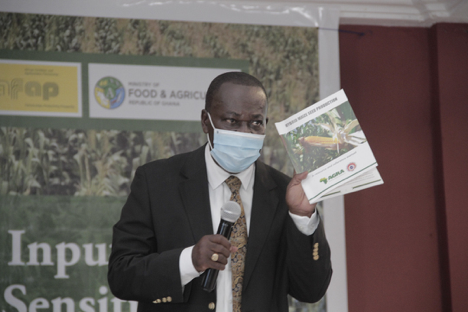In an effort to boost local production of hybrid maize seed to discourage its importation, the Ministry of Food and Agriculture (MoFA) has released a hybrid maize seed production manual.
The 22-page manual was developed by the Council for Scientific and Industrial Research-Crops Research Institute’s (CSIR’s) Crop Research Institute (CRI), Kumasi and Savanna Agriculture Research Institute, Nyankpala-Tamale.
This in line with MoFA’s quest to promote the use of improved seeds to increase productivity which is one of the five pillars of government’s agricultural flagship programmes ‘Planting for Food and Jobs’ (PFJ).
The manual will guide farmers and other stakeholders to produce their own maize hybrid seeds that will guarantee high yields. This will discourage farmers from patronizing imported maize varieties at higher cost and resorting to open-pollinated varieties with low output. This is expected to increase the adoption rate of improve maize seeds in the country.
Launching the manual in Sunyani, Mr. Seth Osei Akoto, Director of Crop Services-MoFA, said the development will not only encourage the use of improve maize seeds in the country but also reduce the country’s import bill as it will become unattractive to import hybrid maize seeds and therefore urged farmers to embrace the manual.
“The adoption of improved hybrid maize seeds has enormous impact on Ghana’s food production. Before the implementation of PFJ, maize productivity was 1.8 metric tonnes per hectare. From 2017 till date, productivity has increased from 1.8 mt to 3.5 mt/ha with open-pollinated variety, while hybrid maize seeds yield is 6 mt/ha. That is why the focus is to encourage farmers to adopt hybrid seeds,” he said.
The hybrid maize seed production manual was launched during the opening session of a two-day ‘Agri Inputs Fair and Stakeholder Sensitization’ held under the theme: “Synergies for agricultural transformation through the value chain approach” in Sunyani. The fair was orgainsed by the ‘Small Holder Inclusive Productivity and Market Access’ (SIPMA) project consortium, MoFA, Crop Life and National Seed Trade Association of Ghana (NASTAG), with the support of Alliance for a Green Revolution in Africa (AGRA).
Rice production
In his open remarks, Mr. Akoto emphasized that government is committed to making the country self-sufficient of rice production by 2023, indicating that to achieve the target, efforts are ongoing to accelerate the cultivation of improved rice seeds, fertilizer application and extension services.
“Currently, the country is about 45 percent rice self-sufficient and in 2021, over 14,000mt of improved seeds will be distributed to farmers to be cultivated on estimated area of 260,000ha. With the current productivity level of 4mt/ha, this will translate into over one million mt of paddy rice. In Ghana, recovery rate of rice processing is about 68 percent. This means it will translate to close to 800 million mt of milled rice, representing about 75 percent self-sufficiency. If the momentum is maintained, I can confidently say that we will attain self-sufficiency by 2023,” he explained.
Digitalization & Post-harvest losses
The Head of Input Distribution and Agro Dealer Development unit, AGRA, Dr. Victor Antwi, stressed the need for more digital infrastructure to speed up the implementation and use of digital mechanisms for agricultural transformation. “With a little investment in digital infrastructure, we can bring on board all the value chain actors and other industry players onto a single platform to guarantee traceability and easy identification. This will help reduce transaction cost, increase the confidence banks, financial institutions and processors have in farmers.”
Commenting on post-harvest losses, Dr. Antwi observed that the perennial canker has bedevilled farming due to mistiming and long production period, especially delay in harvesting as well as storage infrastructural deficit. He said investment in mechanised harvesting and storage facilities will help turn the situation around. He also advanced the idea of value addition at the farm and central levels to reduce the losses. “This is one way we can reduce mechanical damage to farm produce during transportation via our deplorable roads.”










